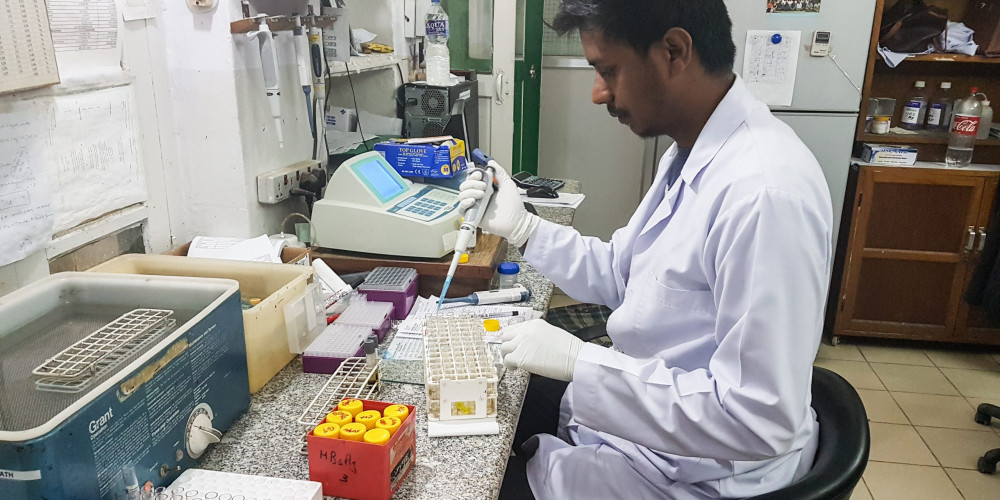KIT Blog
Please keep praying for a vaccine for leprosy.
-
 The Leprosy Mission Australia
The Leprosy Mission Australia
- Oct 13, 2021
- Global,
- India,
- Nepal
By Eva Lee, The Leprosy Mission Australia, International Programs Officer
Over the years scientists have been researching the development of a leprosy vaccine. To date, there are unfortunately no vaccines proven to be highly effective against leprosy.
We need to continue to pray for a breakthrough and wisdom for the researchers.
The current strategies continue to focus on early diagnosis, treating people with Multi-Drug Therapy (MDT) and administering Post Exposure Prophylaxis (PEP) to identified close contacts to reduce the spread of the disease.
It is curious that with such an ancient disease, an effective vaccine has not yet been found. However, th is has to do with the complexities of the leprosy bacteria. Despite being recognised for over 140 years, due to its nature, the bacteria that causes leprosy, called mycobacterium leprae, has remained stubbornly resistant to cultivation in a laboratory. This means that scientists have been unable to grow the bacteria in a petri dish and due to this, it has been difficult to study the disease outside of the human body.
When a bacteria can be grown in a laboratory, it allows scientists to study the movements of the bacteria in detail, thus providing invaluable information about how bacteria lives and multiplies, which in turn allows development of effective methods to eliminate it.
Unable to grow the Leprosy bacteria in a petri dish, scientists turned their attention to growth in animal models. Early attempts yielded little success, but breakthroughs over the years have identified that the bacteria can be grown on the footpads of mice. In addition, armadillos were found to be natural hosts of the bacteria.
These breakthroughs boosted global knowledge of Leprosy. Based on knowledge and modelling from data obtained from these animal hosts, vaccine testing is currently underway.
However, another obstacle in vaccine research is the extremely slow growth of the leprosy bacteria, taking approximately 11-13 days to multiply.
In comparison, the bacteria that grows on food multiplies every 4-20 minutes! This is also the reason why leprosy may not appear in humans until anywhere between 3-20 years after they have been infected. As a result of slow growth rates, experiments can take a significant number of years to yield results.
Although there are many obstacles to vaccine research, there have been trials and potential progress in this area.
 Stanley Browne Laboratory (SBL) of The Leprosy Mission Trust India (TLMTI) is involved in national and international collaborative research studies on various aspects of leprosy. Some of the areas of research are: host response to M. Leprae; understanding the mechanism of exaggerated host response (reactions); transmission patterns in the community and households; emergence of drug resistant bacteria; and development of an early diagnostic test.
Stanley Browne Laboratory (SBL) of The Leprosy Mission Trust India (TLMTI) is involved in national and international collaborative research studies on various aspects of leprosy. Some of the areas of research are: host response to M. Leprae; understanding the mechanism of exaggerated host response (reactions); transmission patterns in the community and households; emergence of drug resistant bacteria; and development of an early diagnostic test.
One of the biggest potentials is the vaccine against tuberculosis (TB), called BCG (Bacillus Calmette-Guerin). There is evidence that this vaccine can offer some protection against leprosy. This is due to the fact that the organism that causes leprosy is similar to the one that causes tuberculosis. Some evidence has been found that combining the leprosy bacteria with the BCG vaccine has offered some protection, particularly in younger children. However, the evidence varies dramatically between studies and protection appears to wane over time. Therefore, although this offers potential, researchers recognise that the BCG vaccine is not a perfect solution for combating leprosy. This is demonstrated in countries where leprosy transmission continues to remain high even though much of the population has received the BCG immunisation.
In addition, as mentioned above, due to the long incubation period of leprosy in humans, when conducting vaccine trials, it would require years of monitoring and follow up to discover if the vaccine is effective.
Although there is still a long way to go in developing a proven vaccine, there is no doubt that a successful vaccine can radically advance the progress in our fight against leprosy.
An effective vaccine would significantly decrease leprosy transmission, a major obstacle in leprosy elimination.
Therefore, in addition to making continued improvements in early diagnosis and treatment, it is important for vaccine research to continue in the background.
Please continue to pray that a safe and effective vaccine will be found for Leprosy soon.
 Research laboratory at Anandaban Hospital
Research laboratory at Anandaban Hospital
Thank you for your support.
Your Post-Exposure Prophylaxis (PEP) project in Indonesia helps ensure health centres in lndramayu are equipped to refer, diagnose and manage Leprosy cases. Indonesia currently has the third highest number of new Leprosy cases in the world. Please pray for the success of this project. If you are inspired to support this project and other contact tracing initiatives across the world, please donate on the response form enclosed or go to www.leprosymission.org.au
References: Bennet, B, Parker, D & Robson, M, 2008, 'Leprosy: Steps Along the Journey of Eradication', Public Health Reports, vol. 123, no. 2, pp. 198-205.
Duthie, M, Gillis, T & Reed, S, 2011, 'Advances and hurdles on the way toward a leprosy vaccine', Human Vaccines, vol. 7, no. 11, pp. 1172-1183.
Lahiri, R & Adams, L, 2016, Chapter 5: Cultivation and viability Determination of Mycobacterium leprae, International Textbook of Leprosy.













